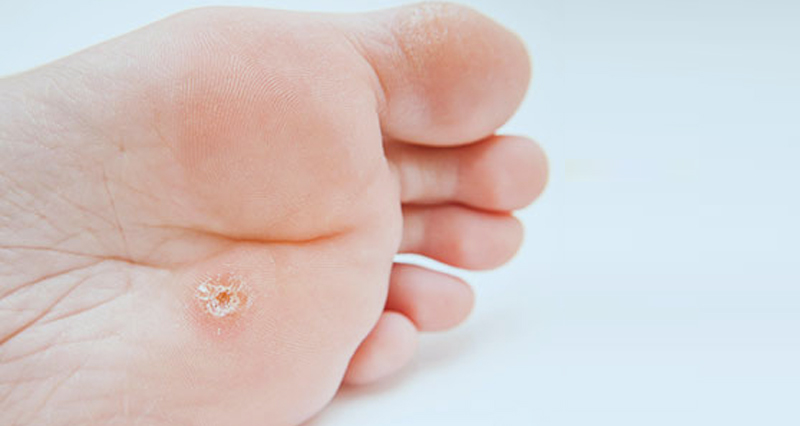admin
Latest posts by admin (see all)
- Wart Cream: Which One to Choose? - October 14, 2019
- Wart Freeze: How Does the Cryodestruction Take Place? - October 11, 2019
- How to Use Salicylic Acid for Warts Removal? - October 8, 2019
Plantar wart is a fairly common manifestation of the Pappillomavirus. This type of warts gives its owners a lot of trouble and pain. However, this pathology is curable and with proper therapy, it has a very positive prognosis. There are many ways to get rid of this disease on the feet. Many people, when the first warts appear, try to cure them with natural methods. Often these methods work. However, if you cannot get rid of warts at home, you should not despair.
Modern medicine can remove plantar warts and prevent their recurrence. It must be remembered that most modern methods of radical disposal of skin warts are bloodless and do not entail long-term rehabilitation. In addition, often plantar warts pass independently, without any interventions, within a few months.
Contents
- Treatment of Plantar Warts on Soles and Toes: The Best Ways
- Drug Treatment of Plantar Warts
- Preventive Measures You Should Take Not to Have Plantar Warts
Treatment of Plantar Warts on Soles and Toes: The Best Ways
Although plantar warts are benign lesions, they must be carefully observed. If the warts began to bleed, ache, or itch, then you should not postpone your visit to a specialist. Today, there are several radical ways to remove warts on the feet:
Cryotherapy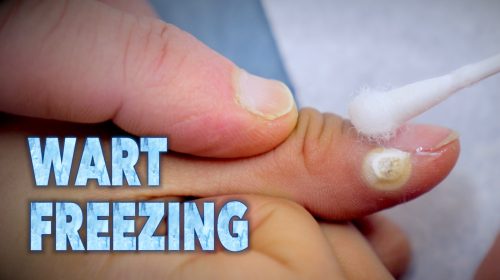
This is a very effective and safe way to remove warts on the feet and toes. The essence of the technique lies in the fact that problem areas are treated with liquid nitrogen. Under the influence of very low temperatures, the plantar wart dies. After 2-3 weeks, the skin is completely restored. The exposure time is usually from 5 to 30 seconds. It all depends on the size of education. For example, large plantar warts require a longer exposure time for the freezing process to affect all layers of the skin. This is necessary to surely cause cryodestruction of papilloma cells. After the first “cauterization” they usually make a short pause – 1-2 minutes. This time is necessary in order to understand how effective the impact was.
Usually, the skin after the first cauterization of the wart with liquid nitrogen becomes white. But after a couple of minutes, it thaws and then you can roughly determine how deeply and extensively the nitrogen affected the skin. Usually, the doctor knows whether to cauterize or there is no such a need anymore. Then all the processes are the same. The skin turned red – then there is the necessary effect. The next day, in 90% of cases, a bubble appears larger or smaller. Do not be afraid of this – this is normal. So everything should flow exactly this way.
The bubble can be filled with a colorless liquid or reddish – it depends on the depth of impact. If the cryodestruction has reached the deeper layers of the skin where the blood vessels pass, then the bubble is reddish. If not, then whitish. The second option is best, when the bubbly liquid is colorless, then after the healing of the scar the skin will not remain. The top of the bladder is just a wart.
Laser photocoagulation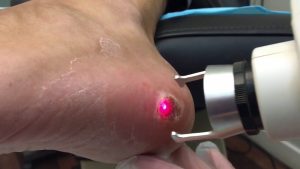
This method is the most modern and progressive. Under the action of a laser beam, the wart tissue simply evaporates. Photocoagulation is non-invasive and has practically no recovery period. The procedure of removal by the method in most cases prevents their recurrence. The same day, it is possible to take water procedures (shower), however, you will have to wait a little with the bath and sauna until the crust disappears. In addition, it is necessary to avoid exposure to ultraviolet radiation in order to avoid the appearance of pigment spots – so removal is better to be done in the autumn and winter period, in the summer you will have to use sunscreen cream (after consulting with your doctor). The wart on the foot is removed bloodlessly and no further infection of the healthy areas occurs.
Electrocoagulation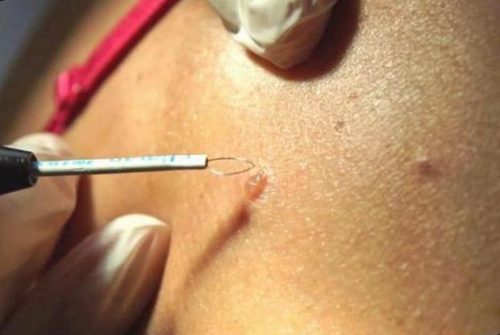
Electrocoagulation of the plantar wart is a method of applying a wetted conductive electrode to the affected area. The other electrode, the diathermic knife, when interacting with the first generates heat, nearby vessels immediately become blocked and the incision is made bloodless. A knife passes a high-frequency electric current heating knife.
This method consists in the fact that a skin tumor is cauterized by a high temperature using an electric current. The negative side of this method is that the procedure of electrocoagulation is quite painful and requires the use of local anesthesia. In addition, after these manipulations, a scar can remain in the place where plantar warts used to be. Electrocoagulation of plantar warts is an effective technology for the thermal elimination of unhealthy cornified growths in the area of soles and heels under the action of electric current.
Electrical destruction has a “cauterization” not only on keratinized tissues but also on the plantar wart itself, which is the main cause of inconvenience. Electrocoagulation is based on controlled thermal elimination of the neoplasm. In the area of coagulation of the plantar wart, a stale crust forms, protecting the maturing new skin. Advantages of electrocoagulation: No painful sensations; efficiency; fast tissue regeneration; high efficiency.
Surgical excision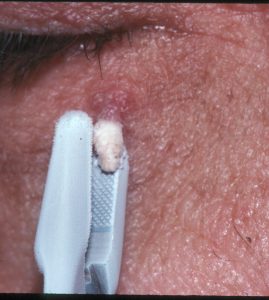
This is the oldest way to get rid of such troubles as skin warts on the legs. Today, this technique is used very rarely, because, firstly, it is painful and requires rehabilitation after its implementation; secondly, in contrast to photocoagulation, electrocoagulation or cryotherapy, the removal of plantar warts with a scalpel inevitably leads to bleeding, and re-infection can occur with blood flow, which means plantar warts will appear again!
Drug Treatment of Plantar Warts
For those who are not sure about the effectiveness of popular methods, but they are not ready for going to doctors, there is also a way out. The pharmaceutical industry produces a large number of ointments, many of which are very affordable and have the proper effect. The most effective of them are:
- Salicylic ointment. This is the most popular remedy for warts. Salicylic acid penetrates into the neoplasm, softens it and promotes its easy mechanical removal.
- Oxolinic ointment. This drug is actively fighting viruses. If you lubricate the sick areas twice a day, you can quickly get rid of such tumors, like warts on the foot.
- This ointment also has a negative effect on the virus, inhibiting it, thereby helping to remove skin tumors.
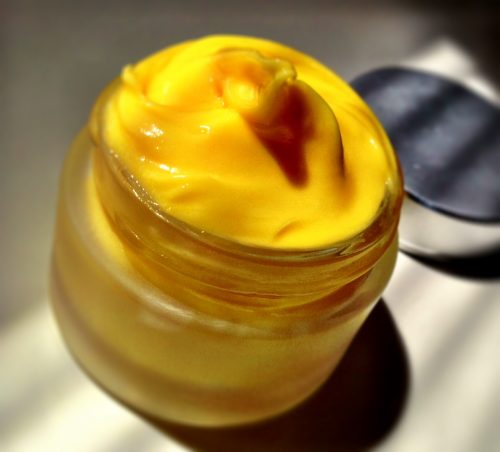
In some cases, these methods of dealing with warty legs are just as effective as minimally invasive measures taken in clinics. Plantar warts disappear within a few weeks.
Preventive Measures You Should Take Not to Have Plantar Warts
Unfortunately, to protect against infection with this manifestation of the papillomavirus is almost impossible. Infection occurs from carriers of this strain, despite the fact that they may not have manifestations of the disease. However, there are ways to ensure that plantar warts do not bother you.
An important role in this issue is played by the high-quality foot hygiene. Increased sweating in this area is a provoking factor and leads to the appearance of plantar warts. In addition, it is necessary to maintain immunity in order not to give the virus a chance to prove itself.
Of course, it is important to choose comfortable shoes that will not constrain the legs during the day. This is perhaps the most important point in the prevention of the appearance of warts on the foot. If you follow these simple rules, you can protect yourself from plantar warts on the feet and toes.
